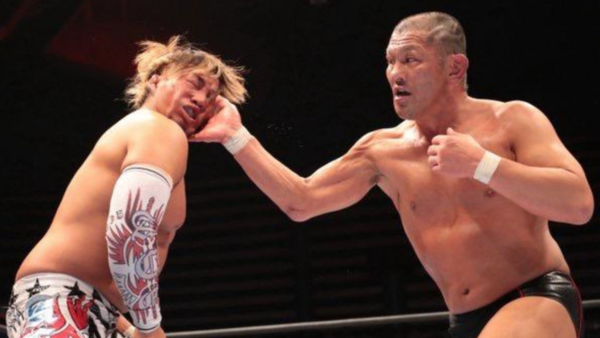Hiroshi Tanahashi Vs. Kenny Omega: The Essential Battle For NJPW

Tanahashi developed this new style, which, per his objective, was indebted to the old, by consciously scaling back on the frequency and force with which moves are struck and taken. Using his classic October 8, 2012 King Of Pro Wrestling match with Minoru Suzuki as an example, the opening exchanges were tentative, and logically so; when faced with a particularly fearsome opponent, especially a title challenger, a champion should be in no rush to put them away. Their exuberance could be easily punished.
From there, heat was generated and story crafted through the targeting of limbs and creative submission escapes (Suzuki’s intent, seemingly, was to maim Tanahashi as much as it was wrest away his title) rather than the excessive use of flashy impact moves. This is not to say that Tanahashi’s matches aren’t stiff, or exciting: the ring ropes and barricades were employed inventively throughout in order to expand the slow-burning, grappling-based through-line. Forceful strikes were used, but withheld until the crowd was sufficiently engaged, so as to maximise the reaction to them. The effect was such that, when Suzuki smashed Tanahashi with a simple dropkick to signal the onset of the finishing sequence, the fans were out of their seats.
That finishing sequence was Tanahashi’s most inventive and influential contribution to pro wrestling. All great wrestling matches are crafted to peak at the finish. This is nothing new. Tanahashi, and then Kazuchika Okada, deviated from the in vogue signature move trade-off device by instead implementing a defensive mind-set. The rush comes not from the kick out, but from the anticipation of the bomb blast. Where previously, the crowd may have reacted to a kick-out with a half-hearted gasp, they instead, under Tana’s spell, produced a nervous cacophony, as if he was scrambling to dig his fingers back onto the cliff edge. The drama of Tana’s finishing sequence intensifies as escapes and counters are exchanged. When the sequence reaches an intoxicating crescendo, the impact of just one move is received as if the preceding decades of excess never happened.
As you may have deduced from the lack of references to this year or last, the bulk of this article was written in 2016. We have used and adapted the original to highlight both the cyclical nature of the industry at its heart, and the fascination underpinning Wrestle Kingdom 13.
Tanahashi’s road has forked in the previous two years.
CONT'D...(4 of 6)